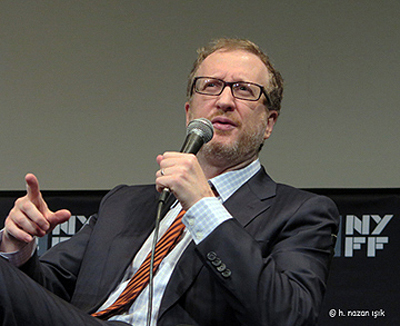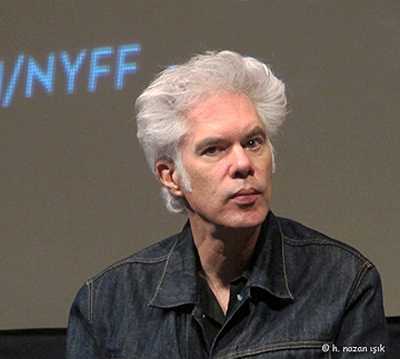h. nazan ışık —
October 13, 2013 —
At almost every film festival or film-related event I attend, I still hear the same question: digital or film? In this regard, New York Film Festival 2013 wasn’t different, and a number of the filmmakers at the NYFF 51 talked about their films, which medium they preferred and why.
Now with the upcoming PhotoPlus International Conference + Expo 2013 — North America’s largest photography and imaging show introducing new products (October 23-26, 2013 at the Jacob Javits Center) — right around the corner, here are several opinions addressing this issue.
photo: © h. nazan ışık
Director James Gray (“The Immigrant”)
Director James Gray’s film The Immigrant takes audiences to 1920s New York as people are making the voyage to the United States in hopes of starting a new life. Among the immigrants landing at Ellis Island is a young Polish woman, Ewa (Marion Cotillard), joined by her ailing sister. Things turn unexpectedly bleak when their aunt and uncle don’t show up to meet them. Ewa’s sister is quarantined because she is infected with tuberculosis. Then Ewa herself is blocked from entry and is threatened with deportation as a “wayward woman.” Into this Gray zone steps Bruno Weiss (Joaquin Phoenix), who, through his connections, gets her released under his protection. Whether this turns out to be good or bad is revealed during the film.
At the press conference held a few days before The Immigrant’s premiere, Gray responded to the issue of shooting with digital or film cameras.
As excerpted below, Gray described his point of view:
“The decision about [using] digital or film is going to be made for us. Film is going to be gone. Although I think it may make a comeback, it will be like vinyl record, or something.
This movie was shot on 35 mm film, but what cinematographer Darius Khandji, (Se7en Midnight in Paris, Amour) and I did was test [shooting it] on Alexa, Red, Kodak and Fuji. Fuji doesn’t make any film any more, by the way. To my mind Kodak looked incredible. But I think [the success of digital] is in the power of what is new. That is in some ways damaging.
Let’s say everybody shot in digital; the whole world used only digital. All of a sudden I came out with a new product and said, “Well, this thing, it doesn’t see in pixels; it sees in grain, which is more like your eyes see. It has better contrast ratio than digital. It has better representation of color than digital and the blacks are better.
Everyone would be like, “Wow, this new thing, film, I am going to change to it.” I don’t understand why everyone wants to migrate to a new medium. That is, in my mind, objectively worst. And it is not even cheaper.
Now, there are some advantages. I think it comes from cinematographers being fearful. What happens is that on digital you can see everything you are getting from the monitor. So, there is no night of terror [waiting to see the rushes the next morning].
I remember when we shot in the sewer system where Joaquin and Marion have been chased by the police, and Darius said, “I did all that but I don’t know what you are going to see.” You can tell [he had a] sleepless night worrying about the lab, the image on the negative and all that. But when the audience sees the movie it doesn’t care about the sleepless night you had.”
Two other NYFF directors who discussed the digital vs. film issue were the co-directors of Manakamana — Stephanie Spray and Pacho Velez. This film details the travels of pilgrims and tourists who go to see the Manakamana Temple in Nepal. Shot in a cable car that carries them back and forth from the Temple, the film was done on film.
Explained co-director Velez:
“The film was shot on 16 mm. We both felt the film is beautiful and we had the budget to afford it. There are advantages that film has over video. Film has a very wide latitude, a bigger range. We were dealing with dark skin in shadows and bright backgrounds. So film let us expose both the characters and these backgrounds. Also 16 mm film has a very rich depth of field to it. We were able to have the characters in focus as well as the backgrounds.”
Added co-director Spray:
“I’ll talk about the conceptual interest. The length of the trip and the roll of the film were the same. There was a correspondence between the media and the duration of the trip. They were all 11-minute takes.”
Another noted director was Jim Jarmusch, whose vampire genre film Only Lovers Left Alive is a love story between the undead Adam (Tom Hiddleston) and his Eve (Tilda Swinton); it was shot digitally.
photo; © h. nazan ışık
Director Jim Jarmusch (Only Lovers Left Alive)
Jarmusch, who has made all of his previous movies on film, explained his decision: “This was the first time I worked with digital photography. We used this camera, the Alexa, which was eeeehhh…
I don’t like digital for several reasons, the depth of field, which is very deep; I don’t like [how it handles] the exterior daylight and it’s effect on skin tones. How it looks was not, not appealing to me.
But [these issues] weren’t problems [for us]. We didn’t have any exterior daylight shots since we were shooting interiors with very low light. We were lighting the scenes with light bulbs and these little LED square lights, and it was very, very minimal.
We didn’t have any depth of field problem. So, the photography here, I found it very beautiful — lit very delicately because of the small lamps.
NYFF51 showcased work shot in both film and digital. No doubt the format debate voiced at the Festival will continue both for filmmakers and still photographers alike.
Photos © h. nazan ışık / NKENdiNEN.com
© h. nazan ışık



Very informative article
It was intersting what Jarmuch said
I will say black and white film. It is so obvious and easy choice for a historical piece!